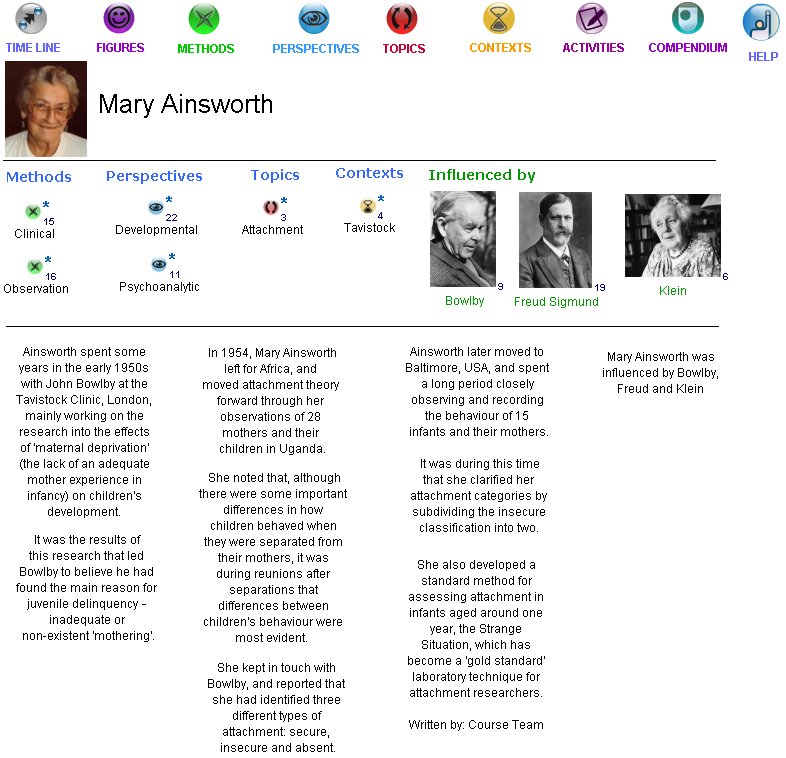
Click icon or label to view this node's details |
Click icon to view map contents |
Click icon to view map contents |
Click icon or label to view this node's details |
Click icon or label to view this node's details |
Click icon to view map contents |
Click icon to view map contents |
Click icon to view map contents |
Click icon to view map contents |
Click icon or label to view this node's details |
Click icon to view map contents |
Click icon to view map contents |
Click icon to view full size image |
Click icon to view full size image |
Clinical observations: case studies. Case studies in clinical medicine involve a detailed account of careful clinical observations, taking the personal history of the patient in relation to the illness, describing the symptoms, diagnosis, treatment(s... |
Click icon or label to view this node's details |
Click icon to view full size image |
Click icon to view full size image |
Developmental psychology focuses on how our psychological characteristics change and develop throughout life, from birth (or, indeed, conception) to old age. Developmental characteristics studied include personality, development of relationships wit... |
Click icon or label to view this node's details |
Click icon or label to view this node's details |
Click icon to view map contents |
Click icon to view map contents |
Click icon or label to view this node's details |
Click icon or label to view this node's details |
Click icon or label to view this node's details |
Click icon to view full size image |
Click icon to view full size image |
| _CONTEXTS_13710825461182935832408.html |
| Ainsworth_13710825461182935845779.html |
| Bowlby_13710825461182935858101.html |
| Klein__13710825461182935850780.html |
The Tavistock clinic (1920-the present). Dr. Hugh Crichton-Miller set up the Tavistock Clinic, London, in 1920, in response to a need for psychological help for people affected by the First World War. From that time to the present, the Clinic has aim... |
Click icon or label to view this node's details |
Click icon or label to view this node's details |
Click icon or label to view this node's details |
Click icon or label to view this node's details |
Click icon to view map contents |
Click icon to view map contents |
Click icon to view map contents |
Click icon to view map contents |
Click icon or label to view this node's details |
Click icon to view map contents |
Click icon to view map contents |
Click icon to view full size image |
Click icon to view full size image |
Observation is clearly distinguished from experiments by the absence of any intervention. The method is often used in everyday social settings to observe behaviour 'naturalistically', but it is also sometimes used in laboratory settings (though often... |
Click icon to view full size image |
Click icon to view full size image |
| _TOPICS_13710825461182935833677.html |
| Ainsworth_13710825461182935845779.html |
| Bowlby_13710825461182935858101.html |
Attachment. This refers to an emotional bond between people, especially used that between babies and very young children, and their primary caregiver (often, but not necessarily, the mother). Some psychologists see the quality and reliability of this... |
Click icon or label to view this node's details |
Click icon to view full size image |
Click icon to view full size image |
Psychoanalytic approaches provide both a psychological theory and a therapeutic method. There is a particular focus on the emotional conditions of early childhood, with many emotional problems in adult life seen as relating to unresolved developmenta... |
Click icon or label to view this node's details |
Click icon or label to view this node's details |
Click icon to follow hyperlink |
Click icon to follow hyperlink |
Click icon to view map contents |
Click icon to view map contents |
Click icon to view map contents |
Click icon to view map contents |
Click icon or label to view this node's details |
Click icon or label to view this node's details |
Click icon to view map contents |
Click icon to view map contents |
Click icon to view full size image |
Click icon to view full size image |